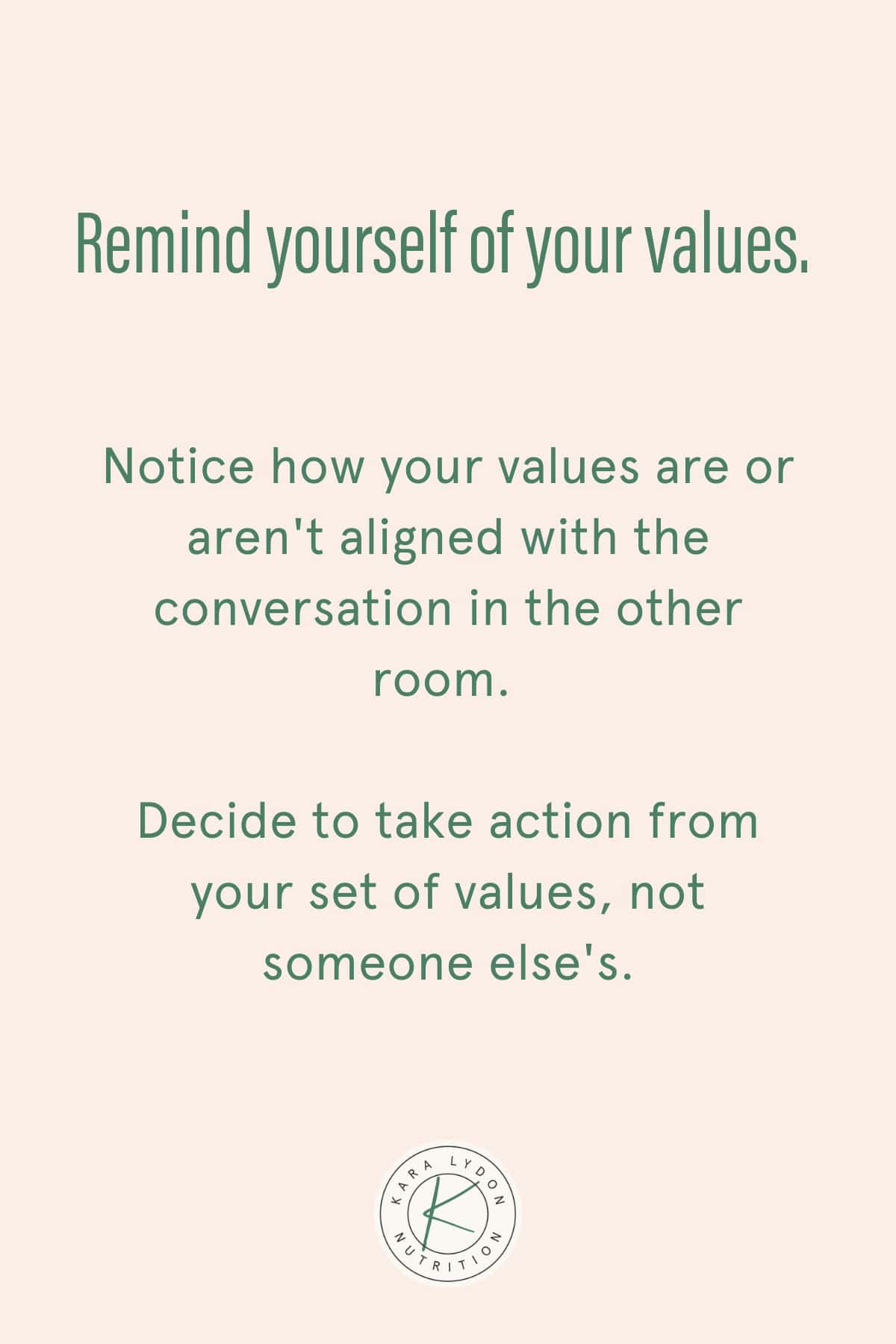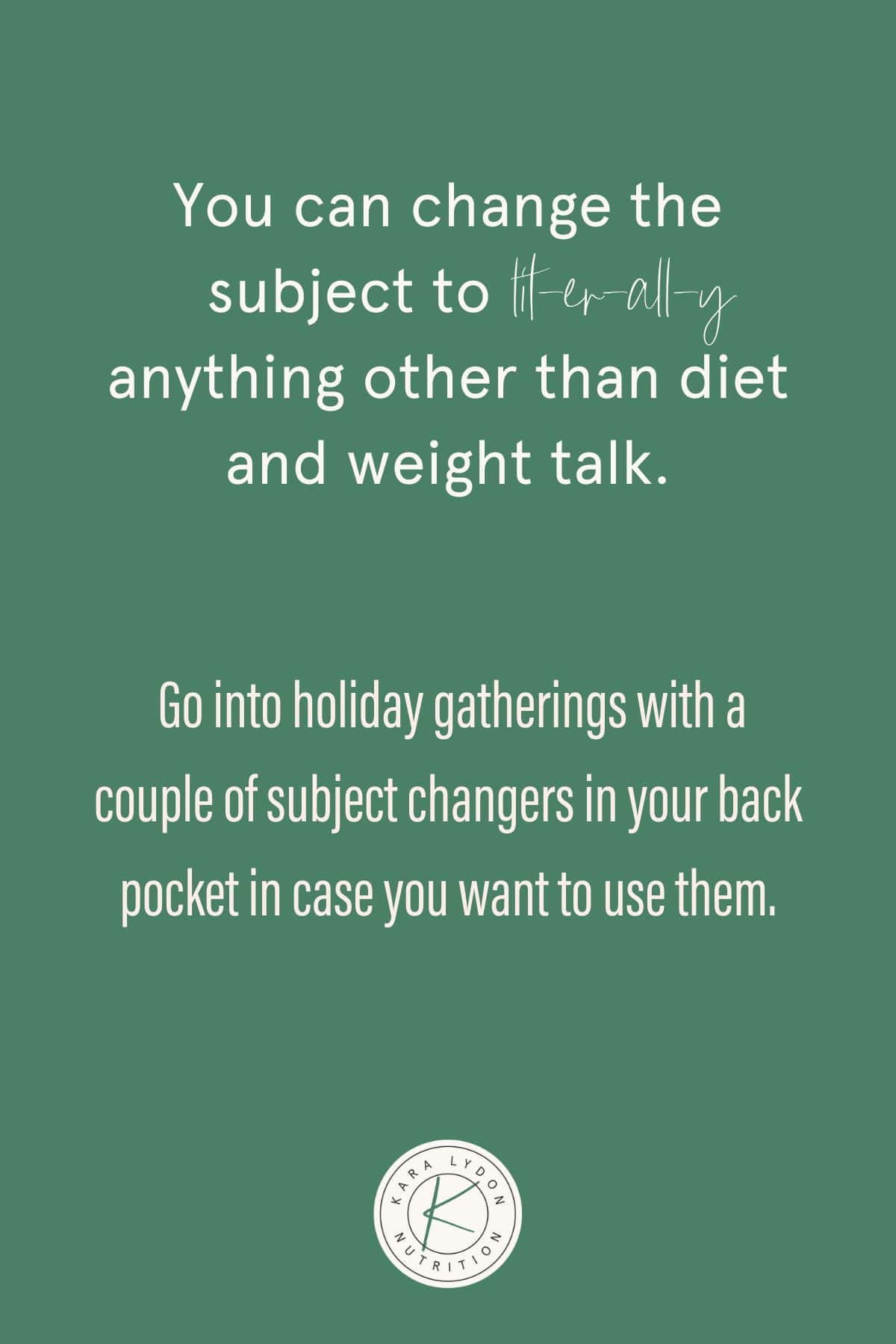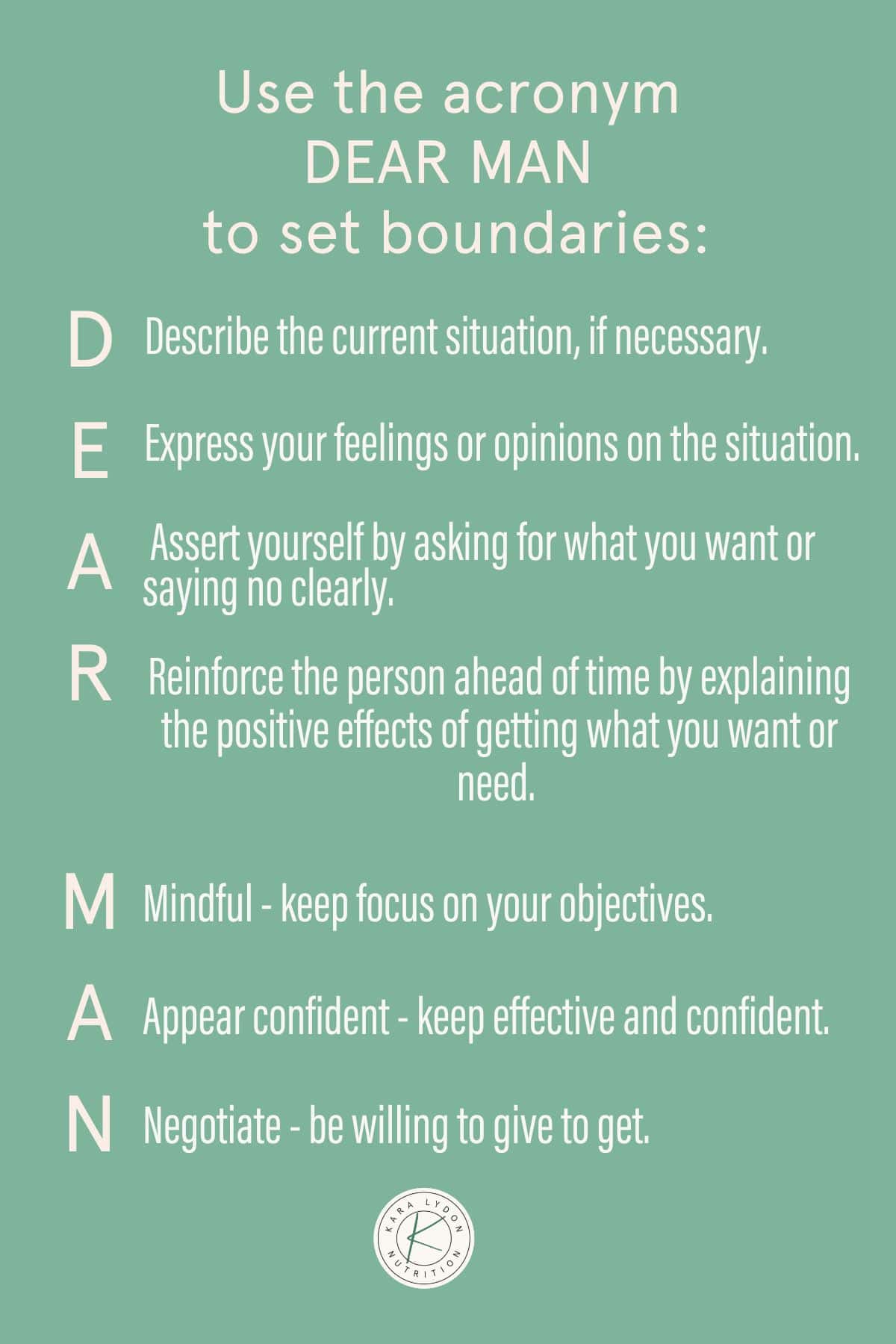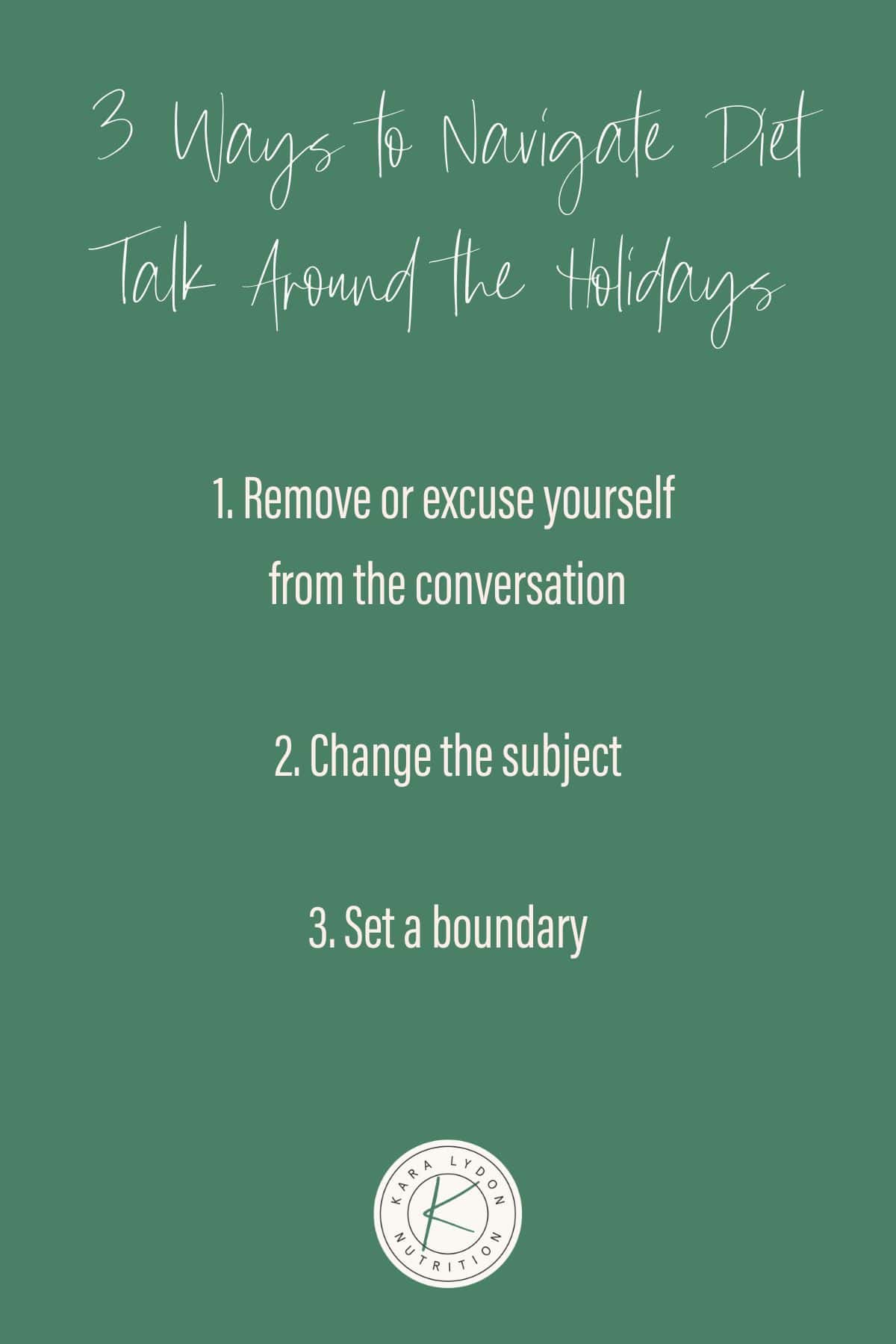3 ways to navigate diet talk around the holidays

Struggle with all the diet talk around the holidays? You’re not alone! Follow these three suggestions for how to navigate food and body conversations during the holiday season.
The holiday season can bring all the feels along with it.
It can be a time of joy, gratitude, connection, cheer, and it can bring along grief, anxiety, and frustration.
One minute you’re kicking back on the couch watching the game savoring your pumpkin pie and the next your aunt is going on and on about how she can’t eat dessert because it’s “loaded with sugar” and she’s “watching her weight.” So much for enjoying that pie!
The holidays can be a breeding ground for diet and weight talk. Everyone is so concerned about what they’re eating, how it doesn’t fit their diet, and how they are going to put on weight over the holidays. And everyone likes to vocalize it (likely so that they can judge themselves before others can).
It’s hard to eat in peace when people are talking about how bad they are for taking seconds of stuffing or how they have to start their diet tomorrow.
It can be hard not to internalize it too. Thoughts begin to surface like “well maybe I should start a diet tomorrow too,” “I guess I’m bad for getting a second serving of those mashed potatoes,” “maybe I should’ve skipped the pie too.”
Part of the work is building resilience so that you can say “good for you, not for me.” And part of the work is knowing your options for navigating diet talk and choosing the best option for you in that moment given your bandwidth and energy at the time.
Here are a few ways you can navigate diet and weight talk during the holidays:
1. Remove or excuse yourself from the conversation.
If you feel like you don’t have the bandwidth or energy to set boundaries or speak up, simply remove yourself from the conversation. Get up and walk out of the room so that you don’t have to hear the conversation anymore.
A strategic bathroom break (even if you don’t need to use it) can be a helpful move. Close the door. Take three deep breaths. Notice what feelings are coming up for you – maybe frustration or grief – give them space to move through you.
Offer yourself some self-compassion for how hard it is to be in those situations when you’re actively trying to move away from dieting and micromanaging your weight.
Maybe you step outside and get some fresh air. Maybe you go check on the little ones in your family if they’re playing in another room. Maybe you go upstairs to a bedroom if it’s accessible and lie down for a few minutes.
Ground yourself and your nervous system. Remind yourself of your values. Notice how your values are or aren’t aligned with the conversation in the other room. Decide to take action from your set of values, not someone else’s.

2. Change the subject.
If you don’t have the bandwidth to set a boundary but you do have the capacity to stay in the room and engage, try changing the subject. You can still engage in conversation, just not the conversation about how many calories were in the stuffing. Here are some examples of subject changing you can try on for size:
Did anyone catch the final score of the football game?
Has anyone watched the latest season of [insert whatever series you just finished binging]?
I just finished this amazing book called [insert title]. Has anyone read it?
What podcasts are you listening to right now?
How is work going?
Did I tell you about my trip to [insert place]?
Your table looks gorgeous. Where did you get those candles?
You can change the subject to lit-er-all-y anything other than diet and weight talk. Go into holiday gatherings with a couple of these in your back pocket in case you want to use them.

3. Set a boundary.
This one requires more energy and mental bandwidth because depending on the person you might be met with defensiveness or you may need to maintain the boundary over and over.
There’s an acronym that comes from dialectical behavioral therapy (DBT) that I like to reference when it comes to setting boundaries – DEAR MAN.
D: Describe the current situation, if necessary.
E: Express your feelings or opinions on the situation.
A: Assert yourself by asking for what you want or saying no clearly.
R: Reinforce the person ahead of time by explaining the positive effects of getting what you want or need.
(this second half is used more so after you’ve stated the boundary)
M: Mindful – keep focus on your objectives.
A: Appear confident – keep effective and confident. Use confident voice tone and physical manner. Make good eye contact.
N: Negotiate – be willing to give to get. Offer and ask for alternative solutions. Reduce your request. Focus on what will work.

Using this acronym, here’s what a couple of boundaries might sound like:
Aunt Phoebe, you’re talking about how bad you are for eating dessert and it makes me feel like I can’t enjoy my slice of pie. I’d like you to stop talking about foods as good or bad around me so that I can be present while I eat and enjoy the company of our family.
Uncle Bob, you keep talking about how you need to lose X lbs and it makes me feel bad about my weight. I would be very grateful if you could refrain from talking about your weight and body size at the dinner table.
If you’re being met with deflection or resistance, using MAN, you might need to say things like:
I’d be happy to talk about (deflection) another time but right now I’d like to stay with the issue I brought up.
What do you suggest then?
And if someone isn’t able to respect your boundary (which unfortunately happens sometimes – usually with the people that need the boundaries the most), then you can work on other skill sets like distress tolerance, radical acceptance, resilience, and emotional regulation.
Boundary setting isn’t easy but it can be very effective to use in relationships. I love the quote by Prentis Hemphil, “a boundary is the distance in which I can love you and me simultaneously.”
Remember that there is no right or wrong answer for how to navigate diet talk – you may use all three of these suggestions but at different times and with different people. Always check-in with yourself first before responding so that you can navigate in a way that honors your bandwidth and capacity.
No matter which option you choose, shower yourself with self-compassion. It’s hard to navigate your own relationship with food and body around the holidays even without the uptick in volume on diet talk. Treat yourself kindly. Remind yourself you are not alone in navigating this.
What else would you add to this list? Tell me in the comments below!

For more intuitive eating inspiration, check out the posts below:
5 Tips for Staying Well Nourished This Holiday Season
3 Ways to Navigate When Clothes Don’t Fit You (without another diet!)
Source link
#ways #navigate #diet #talk #holidays



